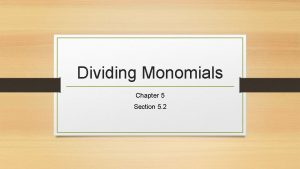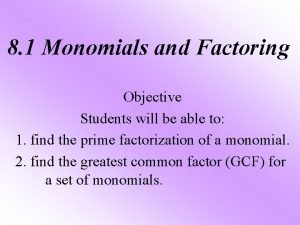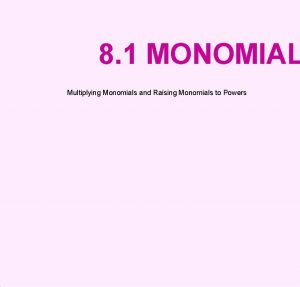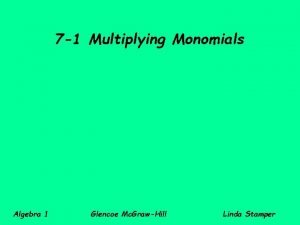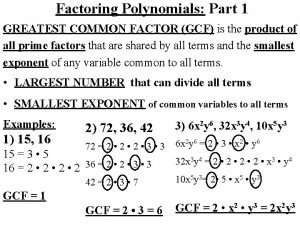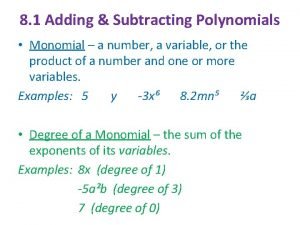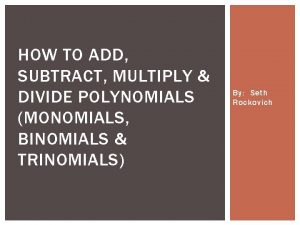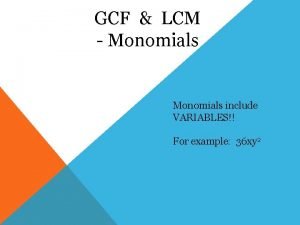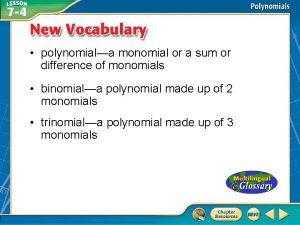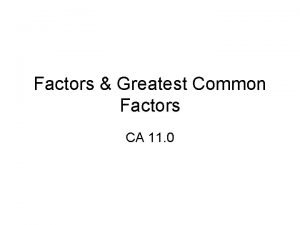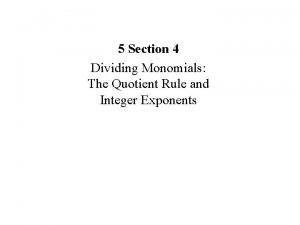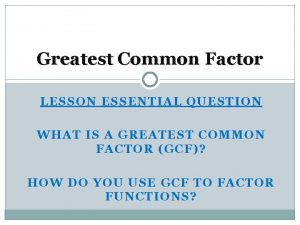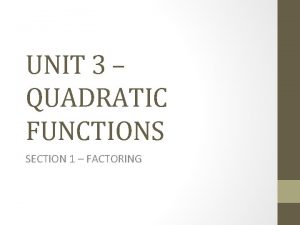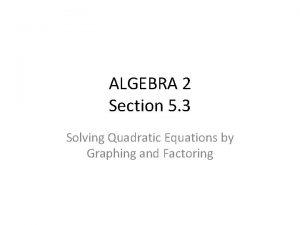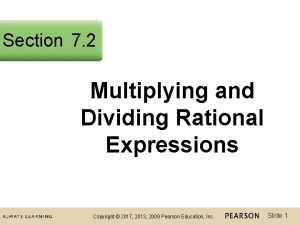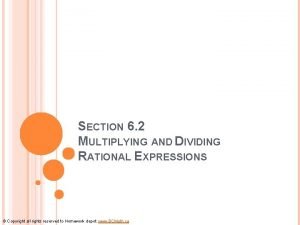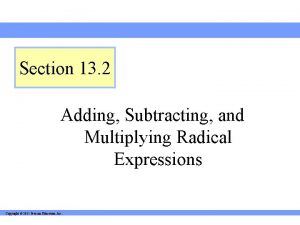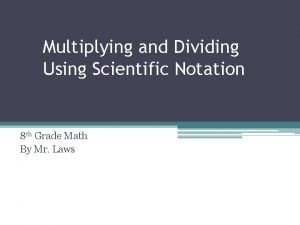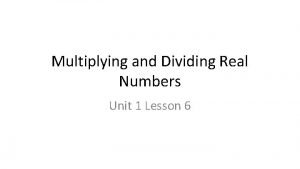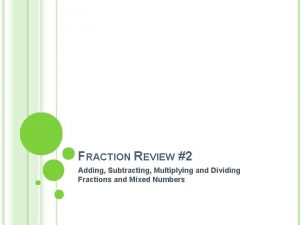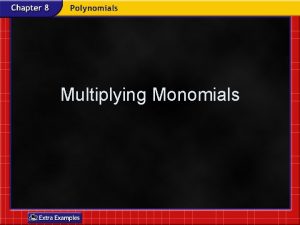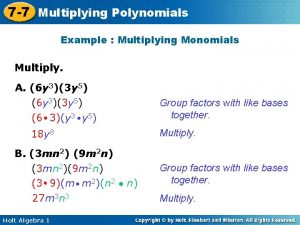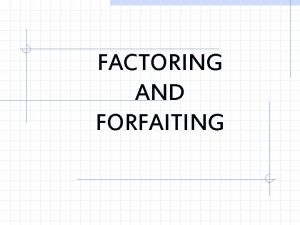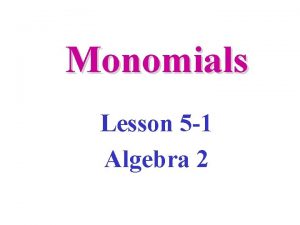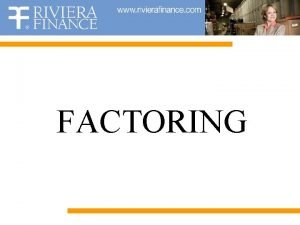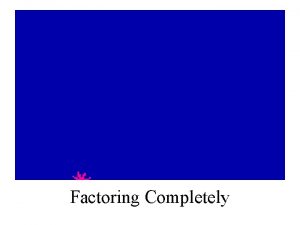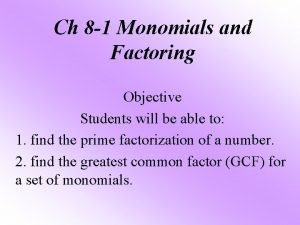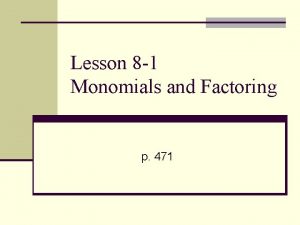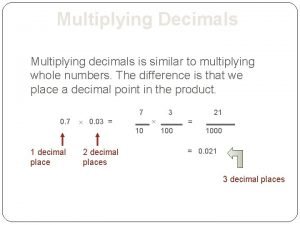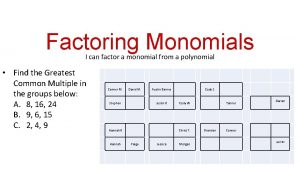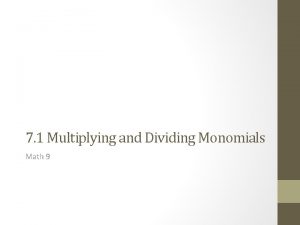Multiplying and Factoring Section 8 2 Multiplying Monomials




































- Slides: 36

Multiplying and Factoring Section 8 -2

Multiplying Monomials Multiply. A. (6 y 3)(3 y 5) B. (3 mn 2) (9 m 2 n)

Multiplying Monomials Multiply. (4 s 2 t 2)(st)(-12 st 2)

Remember! When multiplying powers with the same base, keep the base and add the exponents. x 2 x 3 = x 2+3 = x 5

Your Turn: Multiply. a. (3 x 3)(6 x 2) b. (2 r 2 t)(5 t 3)

Your Turn: Multiply. (3 x 2 y)(2 x 3 z 2)(y 4 z 5)

Multiplying Monomials and Polynomials To multiply a polynomial by a monomial, use the Distributive Property.

Example: Multiplying a Polynomial by a Monomial Multiply. 4(3 x 2 + 4 x – 8)

Example: Multiplying a Polynomial by a Monomial Multiply. 6 pq(2 p – q)

Your Turn: Multiply. a. 2(4 x 2 + x + 3)

Your Turn: Multiply. b. 3 ab(5 a 2 + b)

Your Turn: Multiply. c. 5 r 2 s 2(r – 3 s)

Your Turn: Multiply. d. – 5 y 3(y 2 + 6 y – 8)

Factoring • Factoring a polynomial reverses the multiplication process (factoring is unmultiplying). • When factoring a monomial from a polynomial, the first step is to find the greatest common factor (GCF) of the polynomial’s terms.

Greatest Common Factors that are shared by two or more whole numbers are called common factors. The greatest of these common factors is called the greatest common factor, or GCF. Factors of 12: 1, 2, 3, 4, 6, 12 Factors of 32: 1, 2, 4, 8, 16, 32 Common factors: 1, 2, 4 The greatest of the common factors is 4.

Example: GCF of Two Numbers Find the GCF of each pair of numbers. 100 and 60 List the factors.

Your Turn: Find the GCF of each pair of numbers. 12 and 16 List the factors.

GCF of Monomials You can also find the GCF of monomials that include variables. To find the GCF of monomials, write the prime factorization of each coefficient and write all powers of variables as products. Then find the product of the common factors.

Example: GCF of a Monomial Find the GCF of each pair of monomials. 15 x 3 and 9 x 2

Example: GCF of a Monomial Find the GCF of each pair of monomials. 8 x 2 and 7 y 3

Your Turn: Find the GCF of each pair of monomials. 18 g 2 and 27 g 3

Your Turn: Find the GCF of each pair of monomials. 16 a 6 and 9 b

Your Turn: Find the GCF of each pair of monomials. 8 x and 7 x 2

Factoring out a Monomial Recall that the Distributive Property states that ab + ac =a(b + c). The Distributive Property allows you to “factor” out the GCF of the terms in a polynomial to write a factored form of the polynomial. A polynomial is in its factored form when it is written as a product of monomials and polynomials that cannot be factored further. The polynomial 2(3 x – 4 x) is not fully factored because the terms in the parentheses have a common factor of x.

Example: Factoring the GCF Factor each polynomial. Check your answer. 2 x 2 – 4

Example: Factoring the GCF Factor each polynomial. Check your answer. 8 x 3 – 4 x 2 – 16 x

Example: Factoring the GCF Factor each polynomial. – 14 x – 12 x 2

Caution! When you factor out – 1 as the first step, be sure to include it in all the other steps as well.

Example: Factoring the GCF Factor each polynomial. 3 x 3 + 2 x 2 – 10

Your Turn: Factor each polynomial. Check your answer. 5 b + 9 b 3

Your Turn: Factor each polynomial. 9 d 2 – 82

Example: Factoring the GCF Factor each polynomial. – 18 y 3 – 7 y 2

Your Turn: Factor each polynomial. 8 x 4 + 4 x 3 – 2 x 2

To write expressions for the length and width of a rectangle with area expressed by a polynomial, you need to write the polynomial as a product. You can write a polynomial as a product by factoring it.

Example: Application The area of a court for the game squash is 9 x 2 + 6 x m 2. Factor this polynomial to find possible expressions for the dimensions of the squash court. A = 9 x 2 + 6 x

Your Turn: What if…? The area of the solar panel on another calculator is (2 x 2 + 4 x) cm 2. Factor this polynomial to find possible expressions for the dimensions of the solar panel.
 Division of monomials examples
Division of monomials examples Multiplying and dividing monomials
Multiplying and dividing monomials Powers of monomials
Powers of monomials Monomials and factoring worksheet 8-1
Monomials and factoring worksheet 8-1 Multiplying binomials with exponents
Multiplying binomials with exponents Monomial times binomial
Monomial times binomial Simplifying monomials
Simplifying monomials Gcf of 36 and 90
Gcf of 36 and 90 Subtract monomials
Subtract monomials What is monomial term
What is monomial term A^2-b^2 formula
A^2-b^2 formula Lcm of monomials
Lcm of monomials Highest common factor of 36 and 48
Highest common factor of 36 and 48 Dividing polynomials by monomials
Dividing polynomials by monomials What is the difference between polynomial and monomial
What is the difference between polynomial and monomial A monomial or a sum or difference of monomials
A monomial or a sum or difference of monomials Favtors of 75
Favtors of 75 Quotient rule monomials
Quotient rule monomials Gcf of 12 and 16
Gcf of 12 and 16 What are the factors of 8
What are the factors of 8 Review packet section 1 factoring
Review packet section 1 factoring Section 5 topic 3 solving quadratic equations by factoring
Section 5 topic 3 solving quadratic equations by factoring Section 5 topic 3 solving quadratic equations by factoring
Section 5 topic 3 solving quadratic equations by factoring Multiplying fractions with decimals
Multiplying fractions with decimals Full section vs half section
Full section vs half section Section 2 describing energy (continued)
Section 2 describing energy (continued) Homework 3 multiplying binomials and trinomials
Homework 3 multiplying binomials and trinomials 11-4 practice multiplying and dividing rational expressions
11-4 practice multiplying and dividing rational expressions 6-2 multiplying and dividing radical expressions
6-2 multiplying and dividing radical expressions Adding subtracting and multiplying radicals
Adding subtracting and multiplying radicals Adding subtracting multiplying dividing integers
Adding subtracting multiplying dividing integers Divided by 8
Divided by 8 Multiplying and dividing real numbers
Multiplying and dividing real numbers Multiplication slideshow
Multiplication slideshow Rules of multiplying and dividing integers
Rules of multiplying and dividing integers Multiplying and dividing rational expressions quizlet
Multiplying and dividing rational expressions quizlet Adding subtracting multiplying and dividing fractions
Adding subtracting multiplying and dividing fractions
